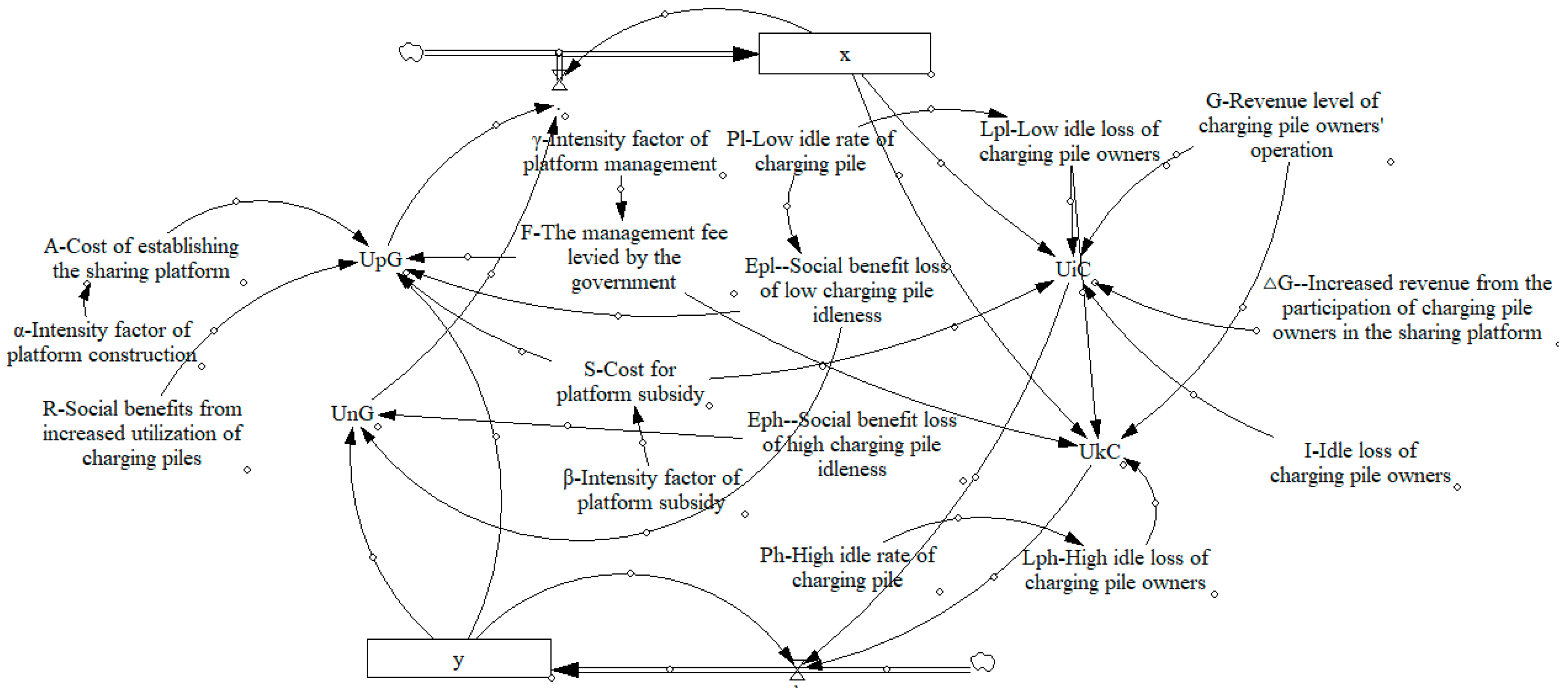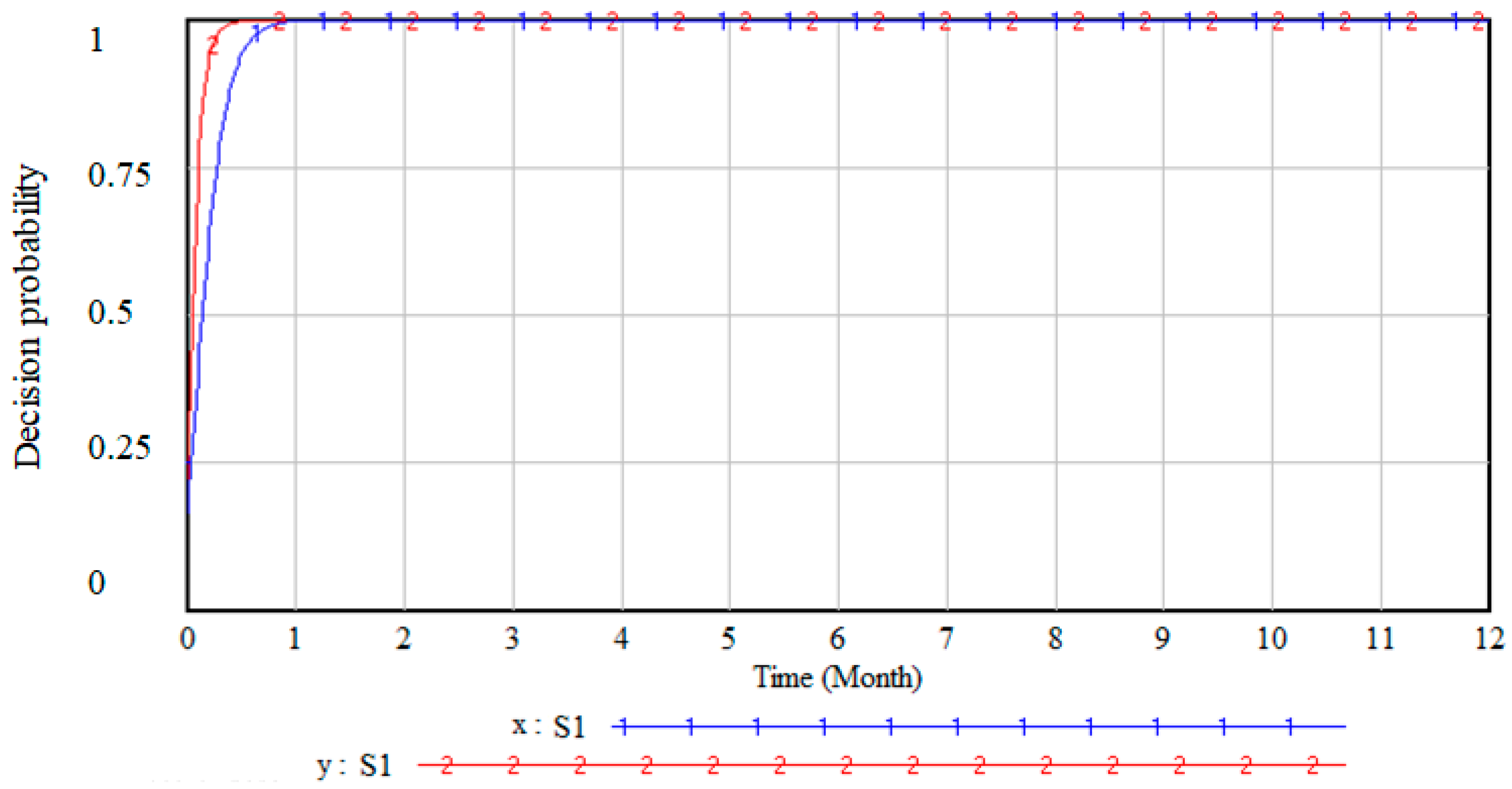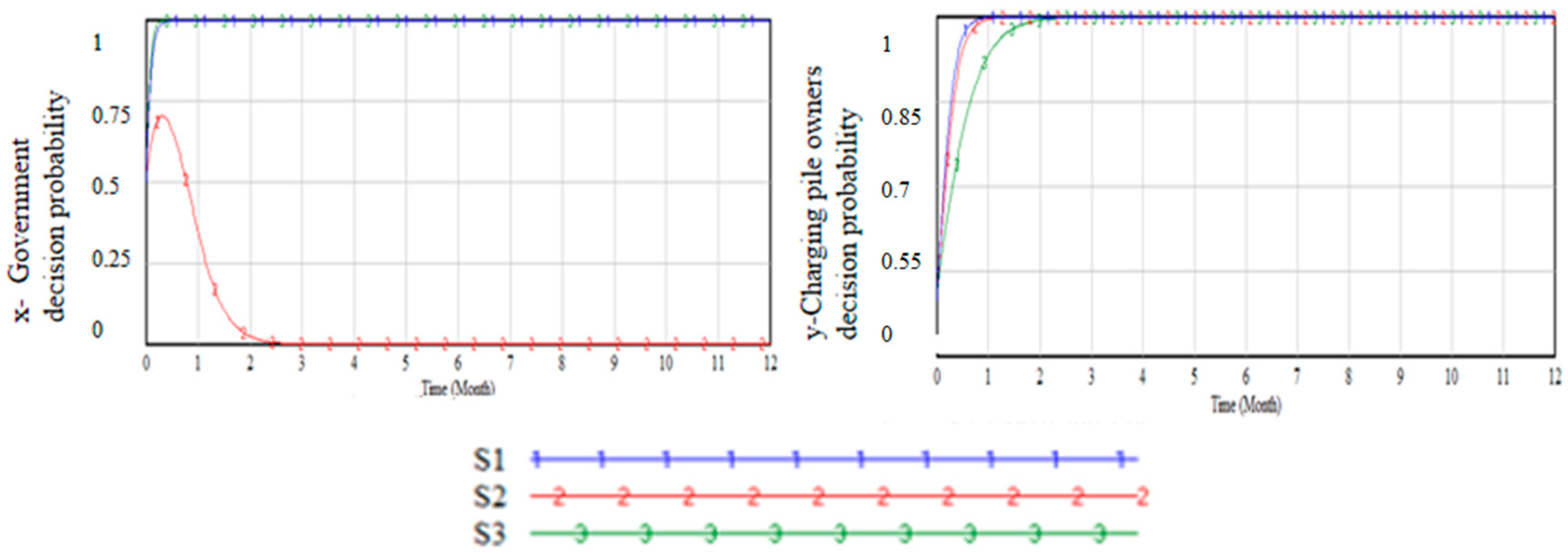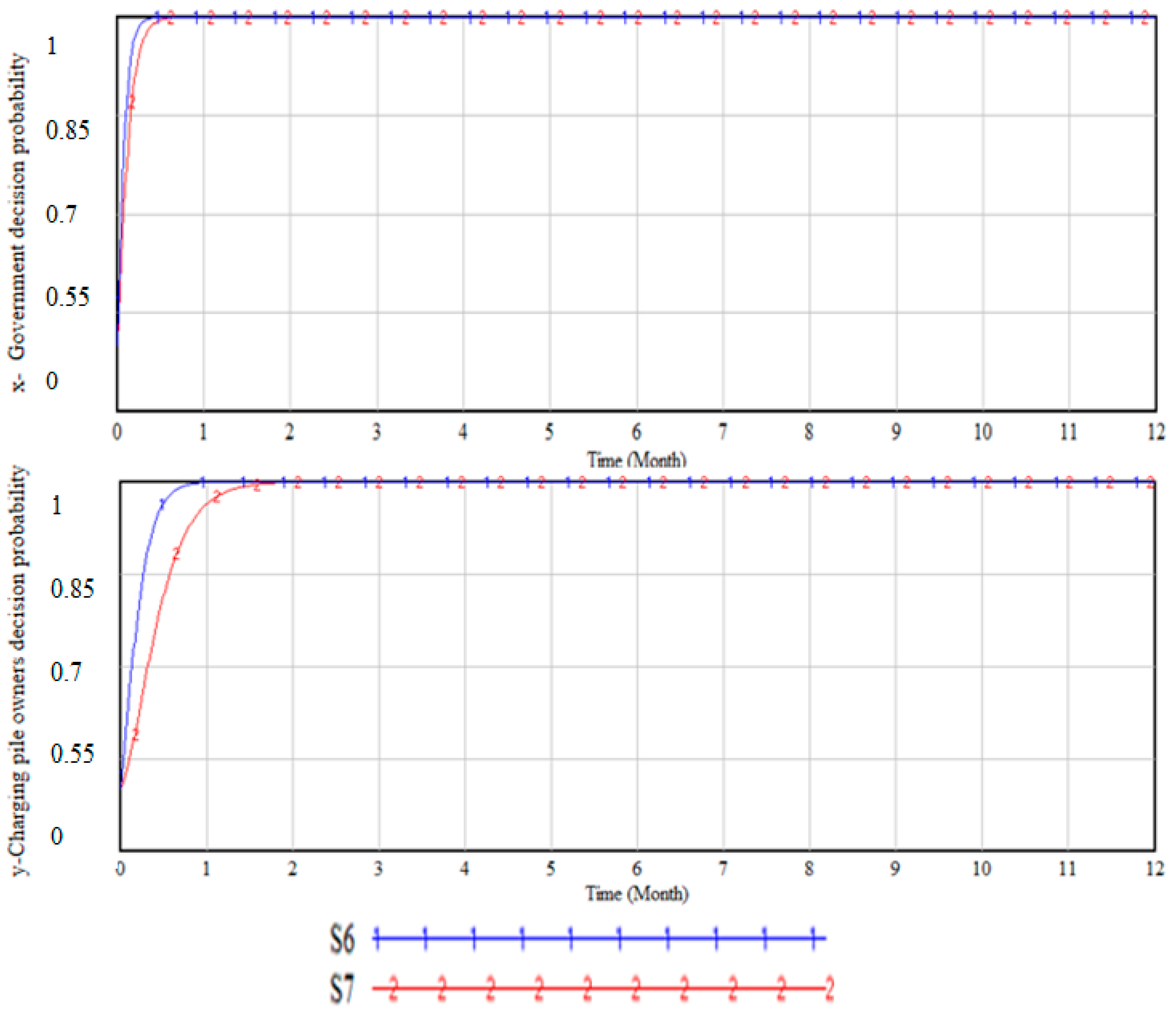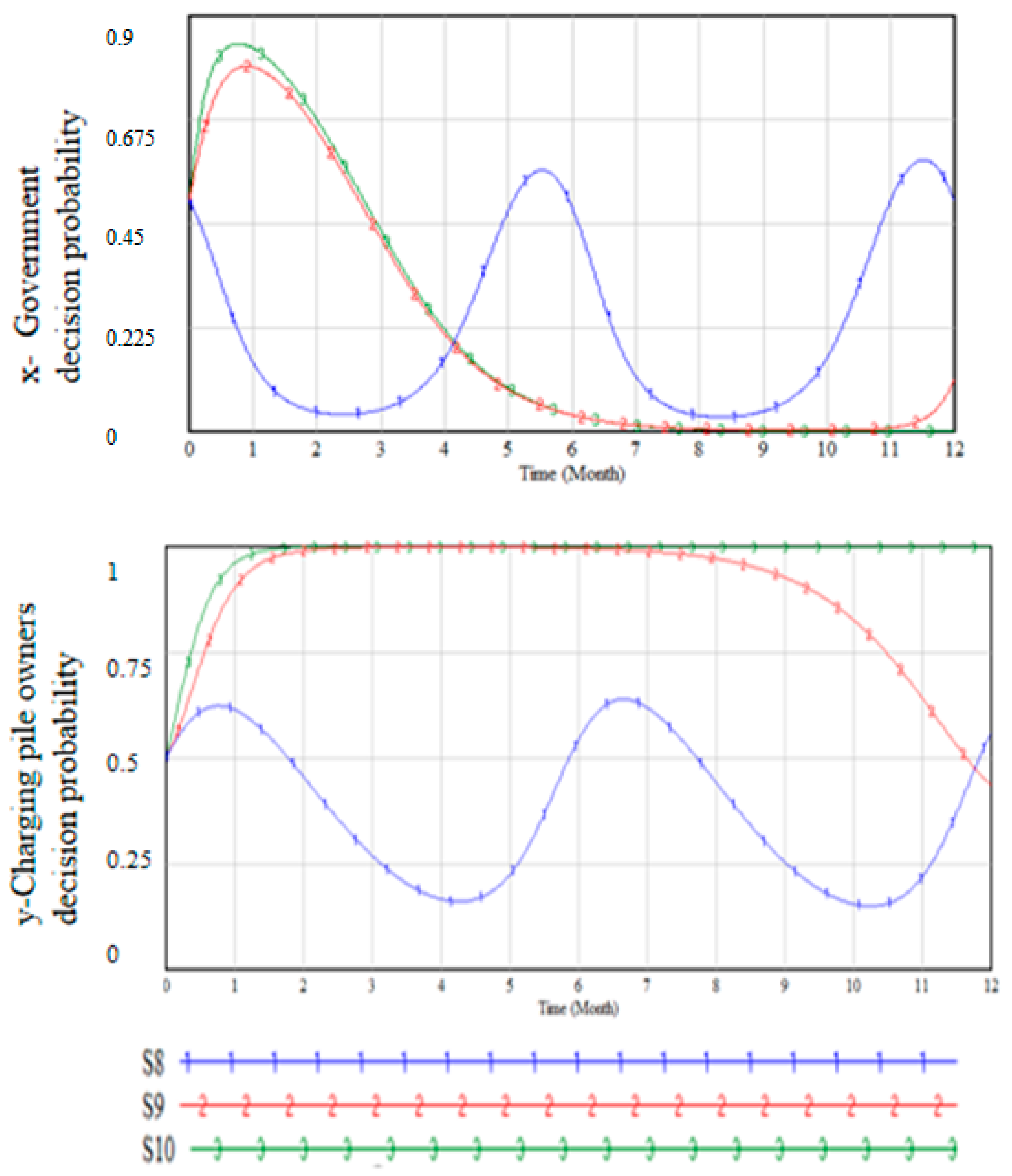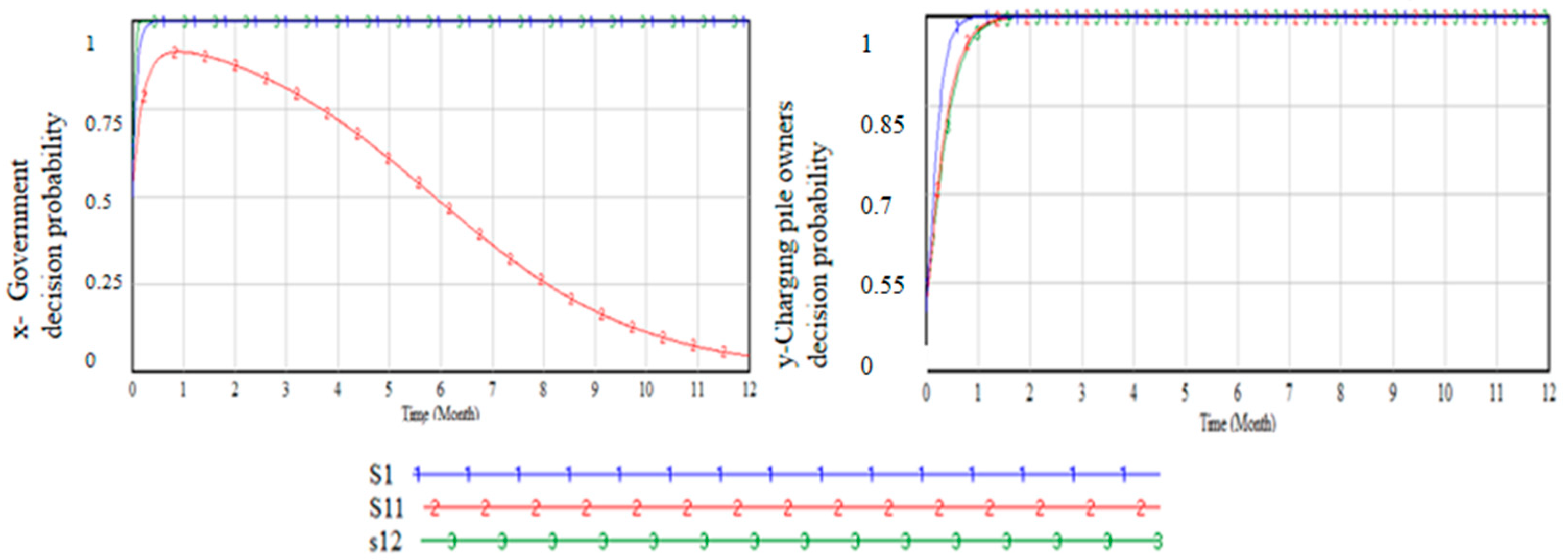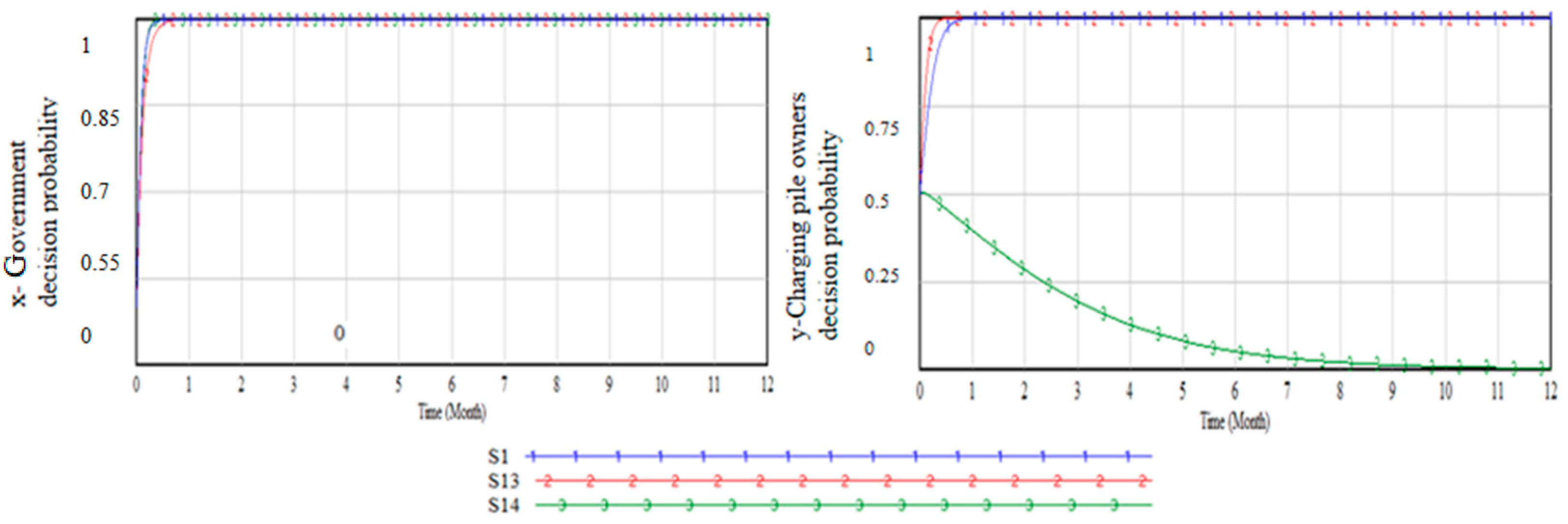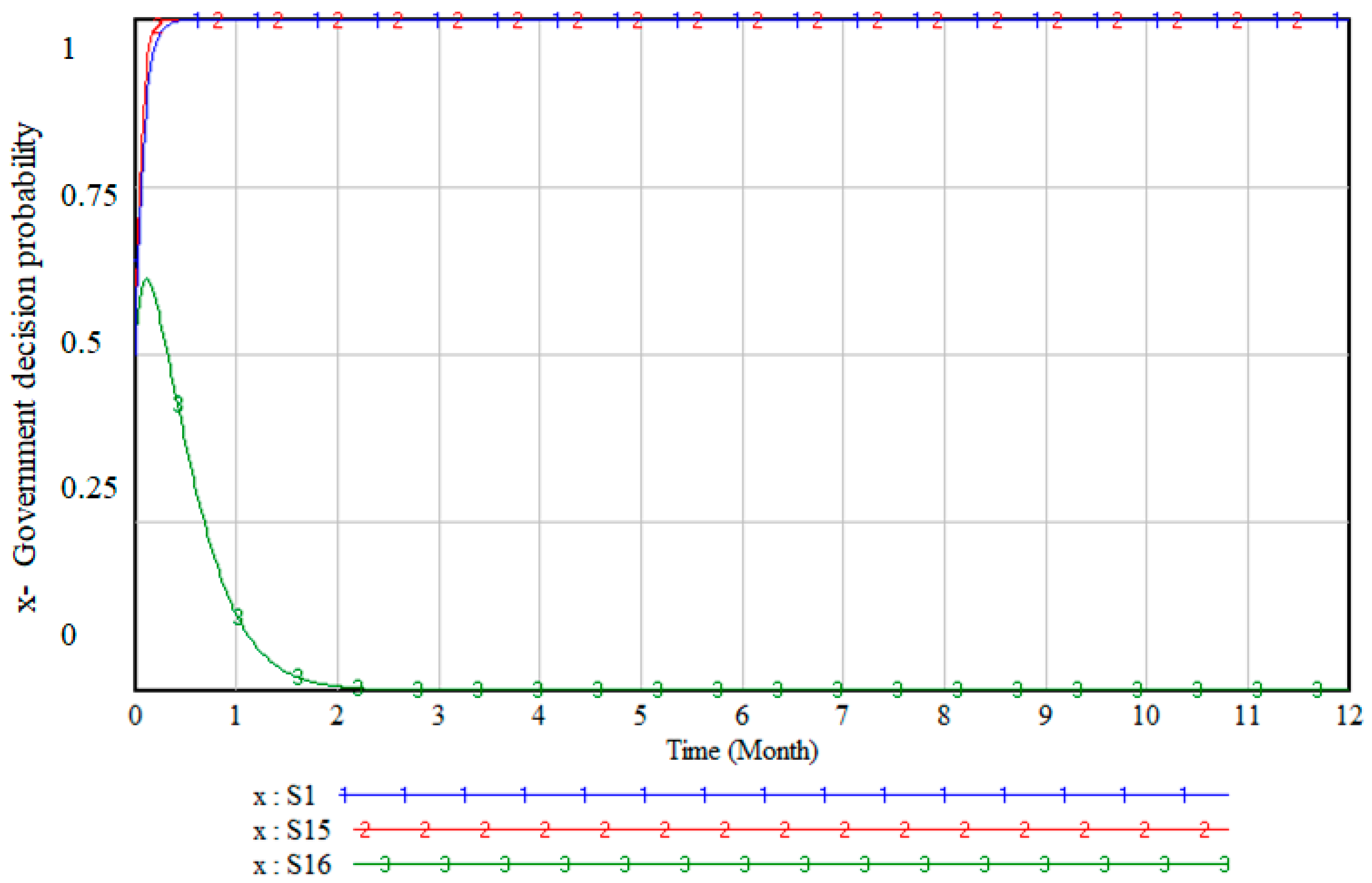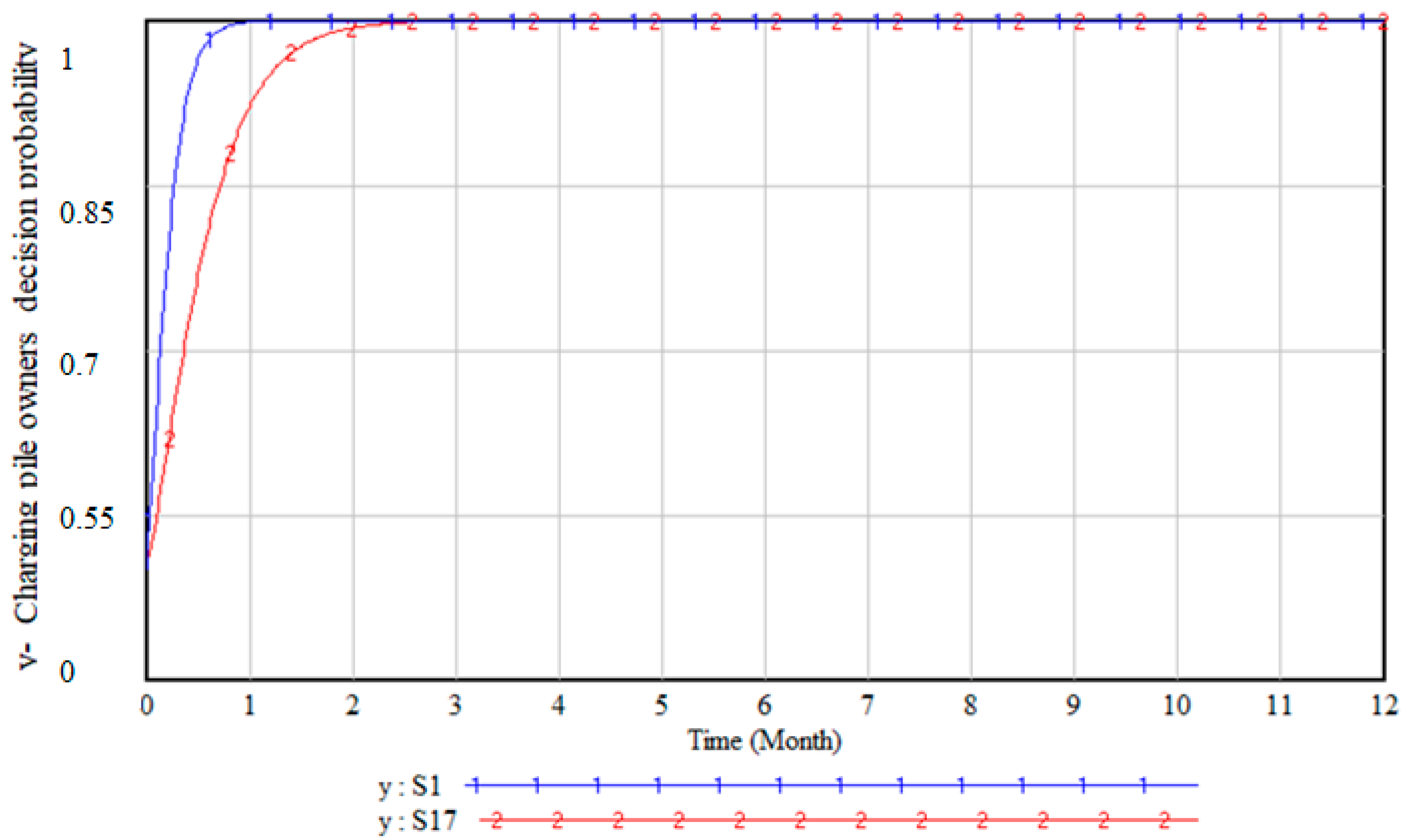4.2. Simulation Results and Sensitivity Analysis for Different Scenarios
The initial conditions of the model are set as follows: the initial time is 0, the final time is 12 months, and the time step is 0.0015625 [
27]. According to the research [
28,
29], based on the real situation and the assumptions of the model, the revenue level for the owner-operated charging station is 100 units, the cost of retrofitting to connect the charging station to the platform for network control and unified settlement is 60 units, the revenue increase for the charging station owner’s participation in the sharing platform is 20 units, the idle loss for the charging station owner is 150 units, and the social efficiency loss for the idle charging station is 200 units. The government’s cost for building the sharing platform is 80 units, the subsidy cost is 20 units, the management fee charged for the charging station operation is 40 units, and the social efficiency gain from the charging station utilization improvement is 150 units. The initial values for
,
and γ are set to 1, while
and
are set to 0.1 and 0.7, respectively [
30,
31].
With the initial values input, the simulation results are shown in
Figure 2. Under the initial parameter conditions, both the platform operator (government) and the charging station owner take active decisions, and a stable equilibrium point (1,1) is reached, which is consistent with the rough analysis of evolutionary stability. Considering the intensity factors
,
and γ, and the charging station idle rate conditions,
and
set in the model, different game scenarios are discussed, and simulation analyses are conducted with different parameter combinations based on the actual situation.
- (1)
Sensitivity simulation for different cost intensity cases
As the proactive measures taken by the platform (government) require expenditure, such as establishing a sharing platform and providing subsidies to platform users, the cost of policymaking has a significant impact on government decision-making. Only appropriate subsidies can stimulate the enthusiasm of charging station owners to join the platform and not cause excessive financial pressure. Different cost intensities will directly affect the value of
. Therefore, it is necessary to discuss the values of the intensity parameter. Situation 1 is the initial parameter and serves as a control. Situation 2 is set to twice the parameter level of Situation 1, where the cost level is higher. Situation 3 is set when the cost level is lower. The value scenarios are shown in
Table 4. The simulation results are shown in
Figure 3.
As can be seen from the results, when the cost intensity increases significantly, the government’s strategy choice changes (indicated by S2), shifting from an active decision to an inactive one. This indicates that cost changes have a significant impact on decision-making, and the formulation of this policy puts significant pressure on the platform party’s (i.e., the government) finances. On the other hand, changes in cost intensity do not alter the decision outcome for the charging station owners, but a significant increase in cost intensity can accelerate their participation rate in platform decision-making.
- (2)
Sensitivity simulation on the intensity of overhead costs of the platform party (government)
In the model design, within the game scenario where the platform (government) takes an active decision but the charging station owner chooses not to, the management fee for charging station operation is not exempted. γ is the intensity parameter for implementing this decision, with γ = 2 representing a high management fee level and γ = 0.5 representing a low management fee level, corresponding to scenarios 4 and 5 in
Table 5, respectively. The simulation results are shown in
Figure 3, compared with the initial scenario 1. The influence of different management fee levels on government policy choices is relatively small. The main impact of government decisions is still the social benefits of the policy, and the financial revenue generated by the management fee has a limited impact on decision-making. The increase in management fee intensity will accelerate the rate of charging station owners joining the sharing platform decision-making, reflecting the sensitivity of charging station owner decisions to costs. The simulation results are shown in
Figure 4.
- (3)
Sensitivity simulation on the idle rate of charging piles
The idle rate of charging piles reflects the actual usage of the charging piles. Personal charging piles are often used 1–2 times a week and have a high idle rate. The overall idle rate of charging piles in an urban area reflects the adaptation level of the overall charging infrastructure configuration, and reducing the overall idle rate is also an important goal for the charging pile platform operation to solve the uneven distribution of charging piles. Setting scenario 6 as the high idle rate scenario and scenario 7 as the low idle rate scenario, the idle rates are shown in
Table 6, and the simulation results are shown in
Figure 5. The decrease in idle rate will also reduce the rate at which the government and charging pile owners make joint decisions on platform sharing.
- (4)
Sensitivity simulation on market development stages
As many cities have already launched related shared charging station construction, the cost of charging station transformation will continue to change with the continuous maturity and progress of technology. Therefore, scenario 8 is designed for the later stage of the market, where the idle rate of charging stations enters the normal range, the shared charging station market tends to be saturated, and the cost of charging station operation and maintenance increases significantly. Scenario 9 represents the mature stage of the market, where the idle rate of charging stations enters the normal range, and the transformation cost gradually decreases to a certain level as the market size expands. Scenario 10 represents the initial stage of the market, where personal charging stations grow rapidly, resulting in a rise in the overall idle rate of charging stations, and the shared charging station market is just starting, with high transformation prices. The coefficient values under each scenario are shown in
Table 7.
Under the condition that the idle rate enters the normal range, the adjustment of the decision-making behavior of both parties increases with the increase in retrofitting costs, leading to unstable fluctuations and making the game process difficult to control. It is challenging to obtain an evolutionarily stable strategy. Additionally, sensitivity simulations for varying cost intensities indicate that the increasing costs of sharing platforms will expedite private charging pile owners’ decision-making to participate in shared charging piles. Furthermore, according to sensitivity simulations on idle rates of charging piles, a decrease in idle rates will reduce the decision rate of private charging pile owners to join shared charging piles. The decision of private charging pile decision-makers is influenced by two opposing factors. The simulation results are shown in
Figure 6. When comparing S8 and S10, it was found that as the cost increases and the idle rate decreases, the stable state of S10 joining the sharing platform changes to an unstable and fluctuating state, similar to that shown in S8 in the figure. This reflects that changes in idle rates have a dominant influence on decision-making.
- (5)
Sensitivity simulation on the parameters of social benefits and charging post owners’ revenue levels
The social benefits reflect the improvement of the travel experience of electric vehicle drivers and the carbon reduction benefits brought by some private car owners choosing to purchase or replace their cars with electric vehicles, due to the overall increase in the use of charging stations in the city. The quantification of this parameter needs to consider both the overall development of electric vehicle travel and the overall social benefits brought by the development of low-carbon transportation in the city. This is challenging to accurately determine and is compared in two scenarios, high and low. Similarly, the normal revenue level of charging station owners is also compared in two scenarios, high and low, with the parameter values shown in
Table 8. The simulation results, as shown in
Figure 7, demonstrate that as the social benefits significantly decrease, the government’s decision-making changes from proactive to inactive. Conversely, the improvement of social benefits accelerates the government’s decision-making process towards a more proactive approach, reflecting the government’s consideration of overall social development. The decision of charging station owners remains unchanged.
- (6)
Sensitivity simulation on charging stake owners’ participation in a revenue-sharing platform
The costs and benefits of participating in a sharing platform are important considerations for charging station owners in making decisions from a business perspective. In this study, we compared two scenarios: one where the benefits of participation increase while costs remain unchanged (Scenario 13), and another where the benefits remain constant while costs increase (Scenario 14). The parameter values used in the simulation are presented in
Table 9, and the simulation results are shown in
Figure 8. When the benefits of participation in the sharing platform increase, charging station owners accelerate their decision-making process to participate. However, when the costs of retrofitting the charging stations increase significantly, while the benefits remain unchanged, charging station owners switch from a participation strategy to a non-participation strategy. The government’s decision remains unchanged, but the speed at which it adopts an active strategy increases when charging station owners switch to a non-participation strategy.
In conclusion, the costs and benefits of participating in a sharing platform are critical factors for charging station owners in making business decisions. As shown in our simulation results, charging station owners are more likely to participate when the benefits increase. However, if the costs increase significantly, they may choose to opt out of the sharing platform. These findings have important implications for policymakers and charging station owners in promoting the adoption of electric vehicles and developing sustainable transportation systems.
The
Table 10 below illustrates the impact of each factor on the decision-making process for both parties, based on a comprehensive sensitivity analysis.
The above analysis provides a more definitive conclusion regarding the impact of individual factor changes and simultaneous changes in multiple acting factors on decision-making for both sides of the game. Subsequently, we conducted further analysis to determine which factor is dominant when two or more factors change simultaneously with opposing effects.
The impact of simultaneous changes in government subsidy intensity and social benefits on government decision-making was analyzed, taking into account their differing effects (
Table 11). Scenarios 15 and 16 were designed to compare against the baseline scenario, where the government’s decision shifts from positive to inactive, while keeping other parameters constant and with a significant increase in subsidy costs. This is depicted by line S15 in the figure, which aligns with the findings of our previous sensitivity analysis. In scenario 16, a significant increase in the social benefit parameter results in a positive shift of the decision, as depicted by line S16 in the
Figure 9. The decision rate also increases, compared to scenario 1, indicating that social benefit has a greater impact on government decisions, even with equal multiplicative changes of both factors.
Three factors, namely participation platform revenue, idle rate, and retrofitting cost with distinct roles, are selected to analyze their simultaneous impact on private charging pile owners’ decision-making process (
Table 12).
Scenario 17 is designed to compare with the initial situation. With all other parameters held constant and indicator values increased by a factor of two, private charging pile owners exhibit a decreased rate of positive decision-making compared to Scenario 1’s initial state, as depicted in line S17 in the
Figure 10. This reflects the greater negative impact of retrofitting costs on decision-making.
